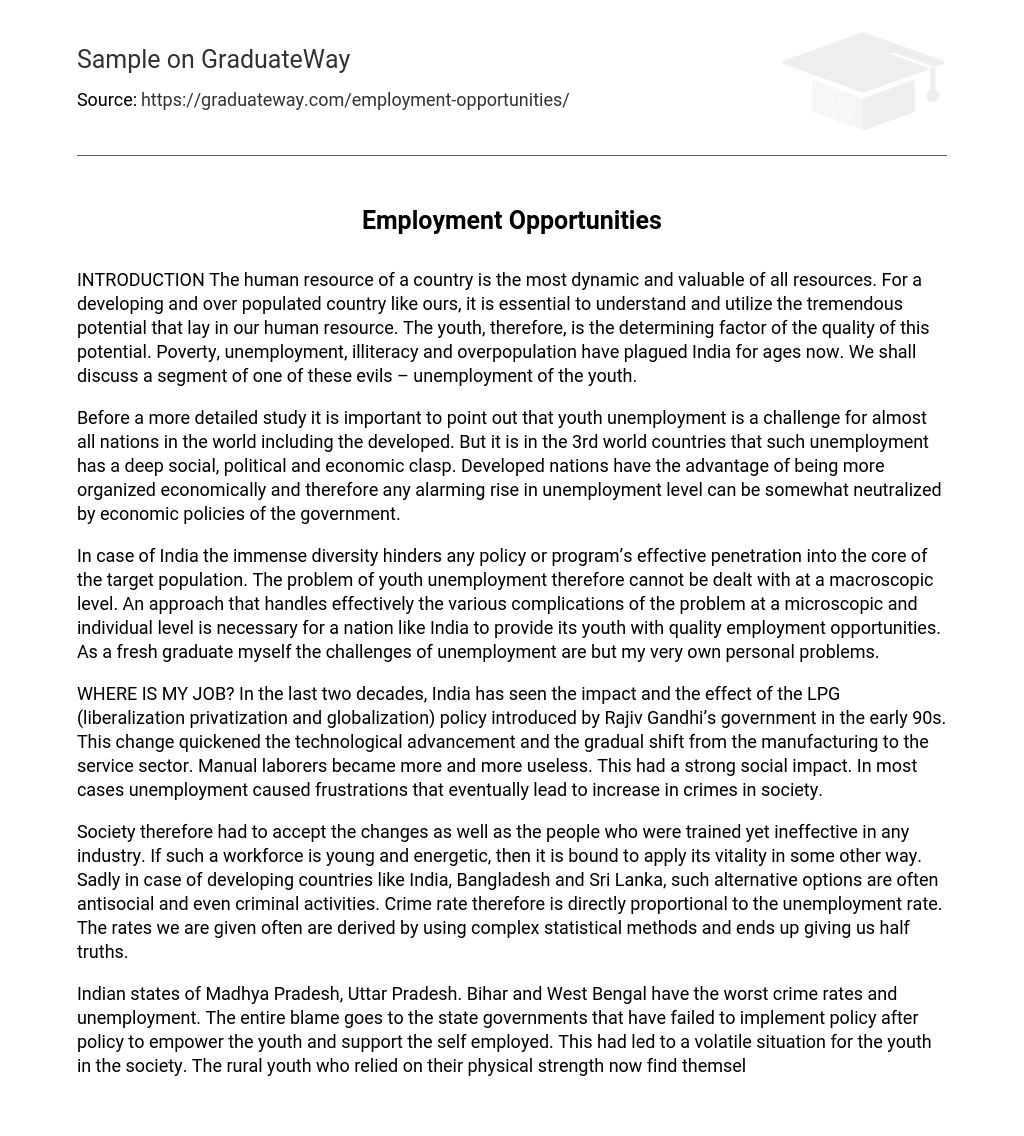INTRODUCTION The human resource of a country is the most dynamic and valuable of all resources. For a developing and over populated country like ours, it is essential to understand and utilize the tremendous potential that lay in our human resource. The youth, therefore, is the determining factor of the quality of this potential. Poverty, unemployment, illiteracy and overpopulation have plagued India for ages now. We shall discuss a segment of one of these evils – unemployment of the youth.
Before a more detailed study it is important to point out that youth unemployment is a challenge for almost all nations in the world including the developed. But it is in the 3rd world countries that such unemployment has a deep social, political and economic clasp. Developed nations have the advantage of being more organized economically and therefore any alarming rise in unemployment level can be somewhat neutralized by economic policies of the government.
In case of India the immense diversity hinders any policy or program’s effective penetration into the core of the target population. The problem of youth unemployment therefore cannot be dealt with at a macroscopic level. An approach that handles effectively the various complications of the problem at a microscopic and individual level is necessary for a nation like India to provide its youth with quality employment opportunities. As a fresh graduate myself the challenges of unemployment are but my very own personal problems.
WHERE IS MY JOB? In the last two decades, India has seen the impact and the effect of the LPG (liberalization privatization and globalization) policy introduced by Rajiv Gandhi’s government in the early 90s. This change quickened the technological advancement and the gradual shift from the manufacturing to the service sector. Manual laborers became more and more useless. This had a strong social impact. In most cases unemployment caused frustrations that eventually lead to increase in crimes in society.
Society therefore had to accept the changes as well as the people who were trained yet ineffective in any industry. If such a workforce is young and energetic, then it is bound to apply its vitality in some other way. Sadly in case of developing countries like India, Bangladesh and Sri Lanka, such alternative options are often antisocial and even criminal activities. Crime rate therefore is directly proportional to the unemployment rate. The rates we are given often are derived by using complex statistical methods and ends up giving us half truths.
Indian states of Madhya Pradesh, Uttar Pradesh. Bihar and West Bengal have the worst crime rates and unemployment. The entire blame goes to the state governments that have failed to implement policy after policy to empower the youth and support the self employed. This had led to a volatile situation for the youth in the society. The rural youth who relied on their physical strength now find themselves worthless in front of the nerds who work mostly with their fingers and eyes. Psychologically therefore there has been a great demoralization of the Indian youth post liberalization.
SOCIAL IMPACT Analysis of the signs of coefficients of socio-economic variables reveals mixed results. Economic growth has actually led to an increase in crime rates. The reason lies in the quality of growth occurring after liberalization. Liberalization operates in many ways: 1. It has increased inequalities, and hence social tension. 2. The capital intensive nature of industrialization has squeezed the growth of employment opportunities for the general PUBLIC. 3. Rising consumerism has led to a sharp increase in consumer demand.
Coupled with restrictions on legal means to satisfy this demand, this may lead to an increase tendency towards relying on criminal means to satisfy this demand. Simultaneously, rising education levels – without any corresponding increase in economic opportunities for the masses – seems to have led to increasing frustration with legal means of livelihood, and increased crime rates. The increasing employment opportunities created by urbanization, on the other hand, seems to lower crime rates. 1 Another problem faced by the Indian youth is the government policies on abour which have backfired badly. MNCs often rely on contracts that subdue the government mandates that make employees almost a liability. For example the political party that was in power in West Bengal for 30 years had made some laws of the state that put great restriction on work hours, Employee provident funds (PFs) and Public Provident Funds (EPFs). Apart from these there was significant pressure on employers to provide good pension schemes and heavy compensations during voluntary retirement(VRS).
All these policies by the government ended up making West Bengal a hostile region for any Industry of international standard to operate. Labour union problems were so severe that even top notch companies like DUNLOP (tyre manufacturers) faced lock outs. The more recent fiasco saw a company the size of TATA MOTORS leave West Bengal fearing further controversy regarding land acquisition and labour laws. The worker belonging to Bengal therefore carried on his unemployed shoulders the great burden of the state policies. He began to be feared by the Employer. And today West Bengal has acquired the name ‘Waste’ Bengal.





